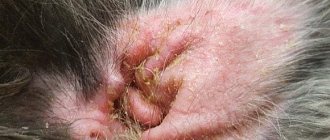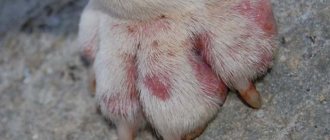Vomiting in a dog is a common symptom of the disease and is characteristic not only of diseases of the digestive tract.
Vomiting in dogs is a fairly common condition. Often during a walk it happens that the dog eats grass and therefore vomits. A dog with a tender and sensitive stomach may vomit in the morning before eating without major consequences. Even more dogs vomit during car rides or when they are under high stress. There are also cases when a dog starts vomiting for completely unknown reasons.
What is vomiting
Vomiting is a reaction of the nervous system to remove food from the stomach - in contrast to the so-called regurgitation, which is the ejection of the contents of the esophagus. Dog vomiting consists of three stages, which always follow one another.
Regurgitation is a symptom of problems with swallowing and occurs with diseases of the esophagus, such as obstruction or paralysis. I'm writing about this because the first step is to differentiate vomiting from regurgitation, which will allow you to know exactly what we're really talking about.
What to do
If your pet’s nausea was a one-time occurrence, then there is no need to worry. This could happen during self-cleansing of the stomach, as a defensive reaction, for example, when swallowing a foreign object, say, a thread, or after eating a herb that causes stomach cleansing.
In this case, it is necessary to carefully examine the mucus and make sure that the cause of its release was a foreign object or grass.
If nausea and vomiting systematically bother the animal, then it should be immediately shown to a doctor, as these signs indicate the possible presence of a disease in the dog.
Common Causes of Vomiting
Regurgitation of stomach contents is most often caused by irritation of the gastrointestinal tract. However, it can occur for a number of reasons - digestive acid buildup, foreign body, infection or poisoning. Some illnesses can also cause vomiting. Here are some causes of vomiting in dogs :
- motion sickness;
- sudden changes in diet;
- the dog ate something unusual;
- ingestion of toxic substances;
- foreign body (piece of toy, bone, clove) in the digestive tract;
- worms;
- bacterial infections of the gastrointestinal tract;
- some viral diseases;
- inflammation of the pancreas;
- nausea after anesthesia;
- sunstroke;
- some medications;
- the kidneys or liver stop working.
Prolonged, repeated vomiting can be caused by gastroenteritis, severe constipation, cancer, or long-term liver or kidney problems.
Causes of mucus nausea
Nausea from mucus can be caused by various reasons, ranging from the most harmless to symptoms of damage to the body by a dangerous illness.
Causes of nausea:
- Digestive problems. The dog's rapid absorption of pieces of food does not allow the food to be completely digested, and undigested food often comes back out along with mucus.
- Fatty, heavy foods can provoke the release of mucus.
- Trying to clear your stomach of swallowed inedible objects, such as pieces of plastic or rubber from toys.
- Poor quality or spoiled food can cause a protective reaction in the body in the form of vomiting to cleanse it.
- Viral infection (leptospirosis, plague, enteritis) is sometimes accompanied by vomiting.
- Poisoning with toxic substances, such as rat poison.
- Stress, which, in addition to fear, fear, can be caused by physical fatigue or solar overheating.
- Infection with worms.
- Malignant tumors in the gastrointestinal tract, liver or gallbladder of the pet.
- An ixodid tick bite and infection with a serious disease - babesiosis (piroplasmosis).
- Digestive diseases: gastritis, ulcers, inflammation of the gallbladder.
- Infectious hepatitis.
Dog Vomit - When Should We Be Worried?
If our pet vomits once and there are no other alarming symptoms, we do not have to take him to the vet immediately. It is enough for us to observe the behavior and well-being of the dog over the next days. However, frequent or repeated vomiting may be a sign of a serious health problem!
Parvovirus, enteritis, or a piece of a toy stuck in your dog's stomach are problems that can even lead to your pet's death if they don't get help quickly enough. If vomiting is accompanied by additional symptoms such as diarrhea, dehydration, loss of weight or appetite, or lethargy, we should immediately take the dog for a thorough examination.
Vomiting in puppies: fasting and drinking water
Before our “YA-VET” specialist arrives or you yourself take the animal to our center, you need to very carefully monitor the condition of the puppy
, as well as the nature of his vomiting. Thanks to your attentiveness, a specialist will be able to make a diagnosis faster. Because he will ask how often the vomit is released, what its character and appearance are. It is of great importance how the pet feels, whether there is an appetite, whether the stomach is swollen, and whether he drinks water. It is necessary to provide the puppy with constant access to water so that the body does not become dehydrated. What is the nature of vomiting in a puppy?
Our specialist will come to your home, provide all the necessary diplomas and certificates, conduct an examination and prescribe the necessary treatment. If the disease is infectious, antibiotics will be prescribed. If the nature is viral, then immunostimulating drugs. In a situation where an animal is vomiting, self-treatment is unacceptable, since the animal may not be cured, but may be harmed. The puppy's condition can be alleviated with the help of a variety of herbal decoctions of mint and flaxseeds. It would be a good idea to stick to a fasting diet.
After the vomiting stops, the puppy can only be given fresh water. The next day, a congee of rice, as well as a special meal. You need to feed in small portions, but often and about five times a day. Your pet will most likely not like herbal decoctions; they must be administered forcibly, about six times a day. You need to start normal feeding on the third day after the vomiting stops.
Vomiting in a dog - one-time, acute or chronic
The first phase is nausea. You can observe changes in your dog's behavior. The animal is worried and salivates. Meanwhile, the dog's intestines move food into the stomach. The next phase is what is known as choking, which is the contraction of the abdominal muscles. The dog breathes deeply and there is a noticeable choking reflex. The last phase is gastric emptying, that is, the release of partially digested stomach contents.
There are three types of vomiting in dogs:
- disposable,
- spicy,
- chronic.
Chronic vomiting usually lasts more than three weeks, while acute vomiting occurs suddenly and lasts several days. Both chronic and acute vomiting are indications for visiting a veterinarian. Vomiting in a dog is often a symptom of various diseases.
It is worth monitoring whether there are other alarming symptoms so that the veterinarian collects the most complete history and makes the correct diagnosis.
Puppy vomiting. What to do if an animal vomits?
The first thing you need to do when vomiting is not to panic. It is necessary to observe the pet for a day. There is no need to scold the puppy, he is already stressed and afraid. Vomiting in a puppy is an uncontrollable process, so he can do it anywhere. It is necessary to place water near the animal. If your dog is vomiting heavily and is not drinking much water, try to force it in to prevent dehydration. This must be done until our specialist arrives. Because treating an animal yourself is very dangerous and can lead to its death.
Vomiting in puppies. What are the causes of vomiting in puppies aged 1 to 50 days who are still feeding on mother's milk?
In small puppies less than 50 days old
, vomiting is mainly caused by congenital pathologies, or vomiting in puppies occurs as a result of a violation of the quality of the mother dog’s milk. Unfortunately, puppies of this age find it difficult to tolerate various medications and therefore most of them die. Naturally, you need to try to cure, but the younger you are, the less chance of recovery. Thanks to mother's milk, puppies have protection from viruses for up to two months. If the mother dog has worms, then they will also pass to the puppies, even during intrauterine development or already during feeding.
Vomiting in puppies: 2 month old puppies that were separated from their mother dog
Many puppies that have been weaned, sold, or given away to other owners often have an upset stomach accompanied by vomiting. This behavior of the body, such as vomiting in a puppy, has three reasons: a sudden change in food or water, worms, and viral infections.
What kind of vomiting happens?
- Vomiting with food contents - most often occurs in the first phase of acute vomiting and with chronic vomiting; the contents may be completely undigested or partially digested - this indicates that the cause of vomiting is most likely related to a stomach disease, or that the dog ate something harmful; It happens that the vomit contains visible fragments, for example, of a bitten toy.
- Biliary vomiting is yellow or yellow-white in color, often with visible foam. Sometimes this is not typical bile, but only gastric juice that comes from an empty stomach. They appear in the next phase of acute vomiting or in chronic vomiting. Typical vomiting of bile comes from the intestines (more precisely from the duodenum, where it is secreted) and often indicates intestinal problems.
- Fecal vomit - comes from the small intestine. It can occur with both acute and chronic vomiting; it often occurs with distal gastrointestinal obstruction or constipation.
- Vomiting with blood - containing blood. This type of vomiting is very serious, if you notice your dog vomiting blood, contact your veterinarian immediately.
Ambiguous phenomenon - vomiting in a puppy
Not only what is in the stomach, but also the contents of the duodenum can come out through the puppy’s mouth. The animal often licks its face, there is a fairly large amount of drooling, and the puppy refuses to eat. All of these changes should alert you because they are signs of nausea, which will lead to vomiting in your puppy.
The puppy may suffer from one or another disease and depending on its nature, vomiting will be different.
Vomiting in a puppy: reasons that can cause vomiting
1Infectious diseases. 2 Poor quality nutrition, which will lead to poisoning of the body. Some time after eating, vomiting begins. A naughty puppy who likes to rummage through the trash and eat something that has long been thrown away can get poisoned. 3Foreign body located in the stomach or stuck in the esophagus. When an animal coughs and vomits, this is the case. Accidentally swallowing an insect can lead to such a reaction. In such a situation, vomiting occurs once. If the puppy has gotten rid of what was bothering him, then there is no longer any reason to worry. Coughing may be the cause of a sore in the mouth that is irritated by caustic vomit. 4Presence of parasites such as worms in the body. 5 Poor intestinal permeability or even obstruction of the intestines, which is a consequence of illness or the animal eating bad food. 6The animal consumed a large amount of food. 7Allergic reactions are present. 8 Consequences of sunstroke. 9Stress. 10 Damage to the central nervous system has occurred.
Pathological vomiting in a puppy is the most dangerous
If toxic substances, spoiled foods, parasites or a foreign body have entered your pet's intestines or stomach, then the reaction of his body will be physiological vomiting in the puppy. Food intolerance and chronic diseases also provoke such behavior in the body, but of a pathological type. Pathological vomiting can be caused by diseases such as:
1Various brain tumors, meningitis, hypertension, encephalitis. 2Kidney disease, uremia, diabetes mellitus. The presence of vomiting may indicate not only poisoning, but also the progression of a serious illness. 3Acute gastritis, stomach tumors, ulcers. As a result of gastric diseases, the gastric mucosa is affected. If there is vomiting of blood, then gastric bleeding is occurring. The isolated masses can have different colors, from scarlet to brown. If the pet is sick with cancer, then the eruption of what is in the stomach will occur after eating food after 5-6 hours. 4Infestation of worms, obstruction of the intestinal tract. Masses released along with bile, and after some time with feces, indicate intestinal diseases. If what is ejected from the mouth is yellow, it means there is bile there. 5Viral diseases, in particular enteritis. 6Kidney disease. Vomiting occurs repeatedly, accompanied by diarrhea, and the smell of ammonia emanating from the puppy is felt.
Physiological vomiting in a puppy
Physiological vomiting is not as dangerous and threatening as pathological vomiting. What to do in such cases is determined by our veterinarian. But it is worth noting that treatment is different in different situations.
.
In order to establish the cause, the animal needs to be examined. The examination can be carried out either at home or in one of our hospitals in Moscow. As a result of the tests, the cause will be determined. The situation when a puppy vomits foam should also alert you. Sometimes this indicates that the pet is hungry. If he is cheerful and behaves actively, then there is no reason to worry. Among all the symptoms of various diseases, a puppy’s vomiting is the most unpleasant, since he does not choose the place where to do it and can empty his stomach anywhere, while causing his owner a lot of trouble. A pet can vomit both in the car and on the carpet. It’s annoying, of course, but you can’t blame him for it. Because it's not his fault that this happened. An animal that has emptied its stomach must be observed for a period of time. If your puppy swallowed something or ate something bad, then one day of general treatment is enough for him to recover. It is necessary to give the puppy small portions of water and you can give activated charcoal. Limit food so that the digestive system can rest.
How to Treat Vomiting in Dogs
To treat this condition, the cause must be correctly diagnosed. When you visit your veterinarian, tell him or her about the frequency of vomiting, any associated symptoms, and the duration of the problem. It can also be helpful to describe the appearance and contents of what your pet is throwing up—it's best to show a few pictures of dog vomit.
If the cause is difficult to diagnose, special tests such as a blood test, stool test, ultrasound, or x-ray may be needed. Depending on the cause of vomiting, treatment may include IV fluids, antiemetics, anti-inflammatory drugs, antibiotics, and even surgery to remove the foreign body from the intestines. In some cases, it will also be necessary to introduce an appropriate diet. However, don't try this on your own - strict adherence to your veterinarian's instructions is important when treating dog vomiting !
What to feed your dog
The first rule is that the dog is not given food for the first 12 hours after vomiting . Therapeutic fasting will allow the dog’s stomach to rest and recover, and the body to cleanse itself. At the same time, you need to offer your dog fresh water (preferably filtered) - 2 teaspoons per 1 kg of weight. In order to restore the salt balance in the body and prevent dehydration, Regidron is prescribed in the dosage indicated on the package.
Subsequently, a special diet is prescribed for therapeutic purposes and for prevention.
Dry food
For therapeutic and restorative purposes, dogs are prescribed special dietary foods:
- Hill's Prescription Diet I/D Canine Gastrointestinal Health dry
- Flatazor Protect Obesite;
- Advance Veterinary Diets Gastroenteric Low Fat Canine Formula;
- Pro Plan Veterinary Diets Canine EN Gastrointestinal dry;
- Happy Dog VET Diet Renal;
- Farmina Vet Life Canine Gastrointestinal;
- Royal Canin Gastro Intestinal Low Fat.
They switch to regular food gradually adding it to the dietary food. At the first feeding the proportion should be 1:1. Then, if vomiting does not recur, you can mix 3/4 regular food and 1/4 dietary food. If the dog tolerates the food well, after 3 days you can return to the normal diet.
Natural food
Naturally fed dogs are switched to light food. After “therapeutic hunger,” the dog is offered 2-3 teaspoons of low-fat, easily digestible food.
It could be:
- skim cheese;
- curdled milk;
- boiled rice;
- steamed beef meatball;
- boiled potatoes;
- oatmeal;
- boiled chicken breast without skin.
You need to feed little by little, but often, offering the dog food every 1-2 hours. For feeding, carbohydrates and proteins are mixed in equal proportions. All food should be without salt and seasonings. The transition to a normal diet is allowed only after 3-4 days.
Important!
If the diet does not help, or your dog continues to vomit, contact your veterinarian immediately.
Causes of vomiting
Dogs have a well-developed gag reflex. Many wild dogs do not hesitate to feast on carrion, so the ability to empty their stomachs of contents often saves their lives. In domestic dogs, it can occur either for natural reasons (physiological) or serve as a sign of another disease (pathological).
Physiological causes of vomiting
If your dog periodically vomits food, there may be several reasons for this.
- Binge eating. Puppies often regurgitate mother's milk and excess food.
- Eating grass. This is how dogs cleanse their stomach. Normally, grass regurgitation occurs several times a month. If the dog vomits 3-4 times a week, then the cause may be worms or too fatty food.
- Sometimes dogs experience hunger sickness in the morning. This happens due to irritation of the mucous membrane by gastric juice.
- Dogs with easily excitable nervous systems may regurgitate food when under extreme stress. Therefore, it is not recommended to feed your pet before a visit to the veterinarian, short trips, or visits to noisy places.
- A dog may get motion sickness in transport; due to a disorder of the vestibular system, the animal begins to vomit.
Pathological vomiting
Attacks of pathological vomiting begin suddenly, are often not associated with feeding, and are repeated many times. The first portions of vomit contain food, then the dog vomits saliva and a small amount of liquid. Such attacks are typical for the following pathologies:
- infectious diseases;
- poisoning;
- foreign body in the stomach;
- helminthic infestation;
- diseases of the central nervous system;
- manifestations of food allergies;
- kidney disease, renal failure;
- overheating, heat and sunstroke;
- non-communicable diseases of the digestive system - enteritis, enterocolitis, pancreatitis, hepatitis;
- surgical pathologies - obstruction, intussusception, tumors.
Pathological nausea occurs frequently; vomit sometimes contains admixtures of bile and blood.
Pathological vomiting is accompanied by signs of nausea, pain in the stomach and intestines:
- profuse drooling;
- anxiety;
- rumbling in the stomach;
- the dog is hunched over or takes a forced position;
- The abdominal wall is tense and painful when touched.
Pathological vomiting is characterized by the presence of diarrhea or constipation in the dog.
The gag reflex can occur with a strong cough (tracheobronchitis) due to irritation of the receptors of the pharynx and larynx.











